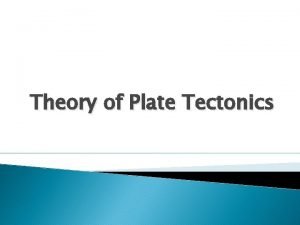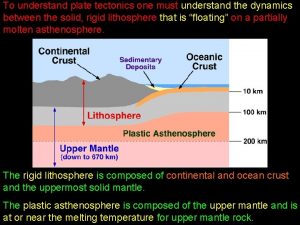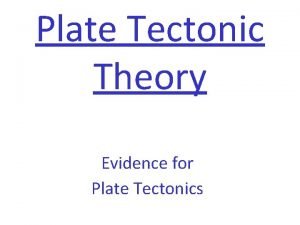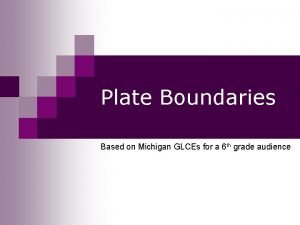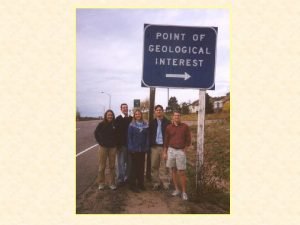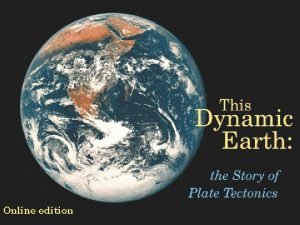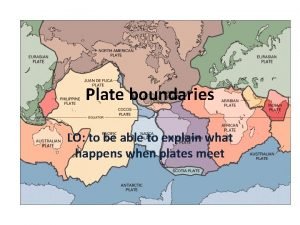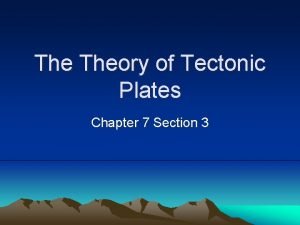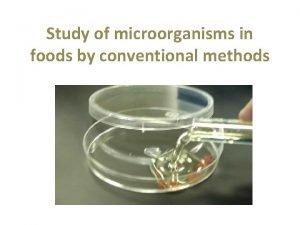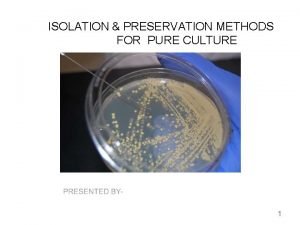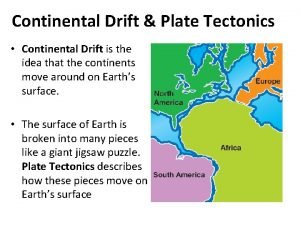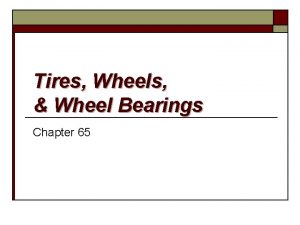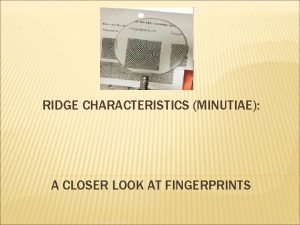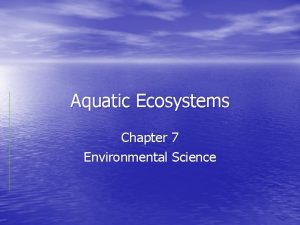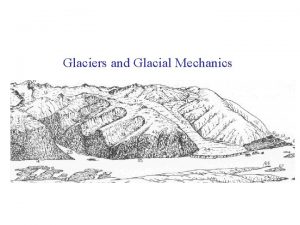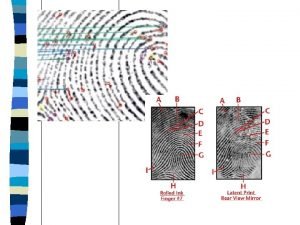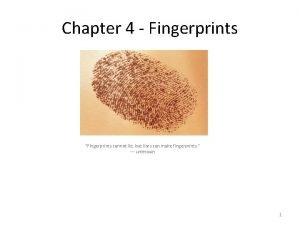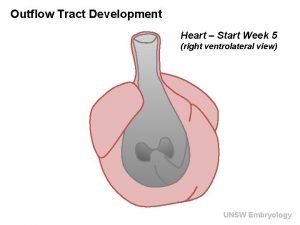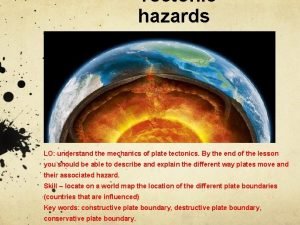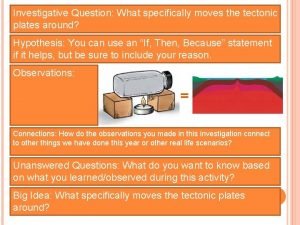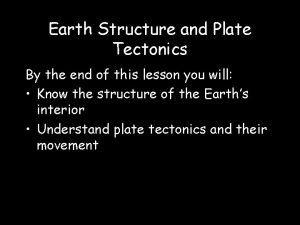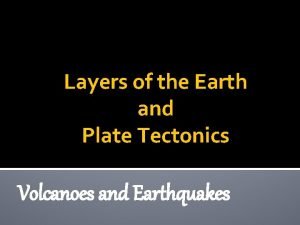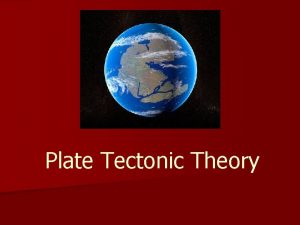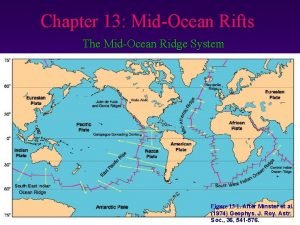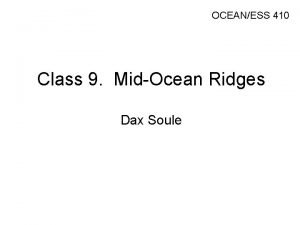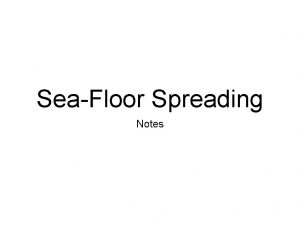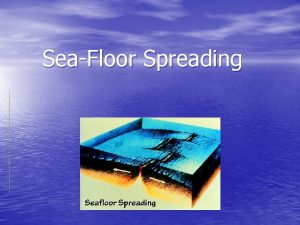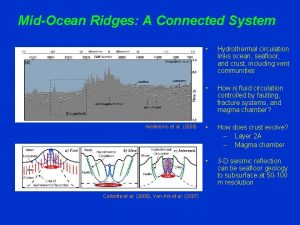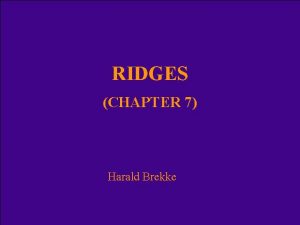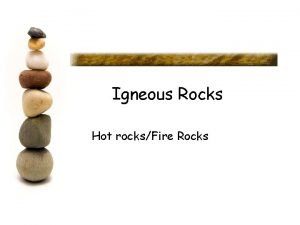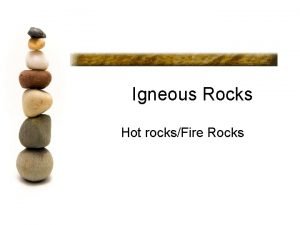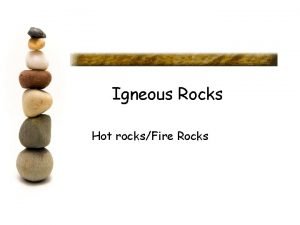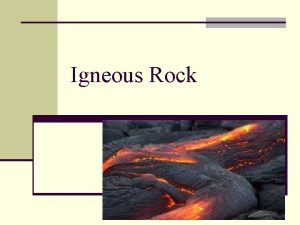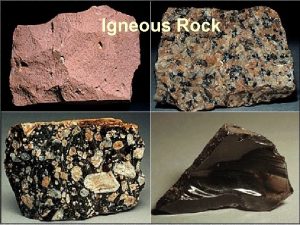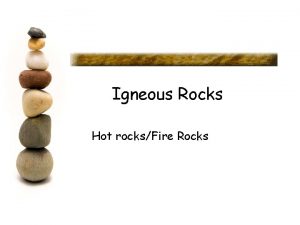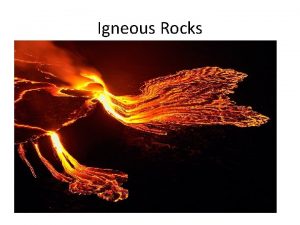Plate Tectonic Igneous Genesis 1 Midocean Ridges 2













































- Slides: 45

Plate Tectonic - Igneous Genesis 1. Mid-ocean Ridges 2. Intracontinental Rifts 3. Island Arcs 4. Active Continental Margins 5. Back-arc Basins 6. Ocean Island Basalts 7. Miscellaneous Intra. Continental Activity u kimberlites, carbonatites, anorthosites. . .

Igneous Minerals l l Quartz, Feldspars (plagioclase and alkaline), Olivines, Pyroxenes, Amphiboles Accessory Minerals – mostly in small quantities or in ‘special’ rocks F F F F Magnetite (Fe 3 O 4) Ilmenite (Fe. Ti. O 3) Apatite (Ca 5(PO 4)3(OH, F, Cl) Zircon (Zr. Si. O 4) Titanite (Ca. Ti. Si. O 5) Pyrite (Fe. S 2) Fluorite (Ca. F 2)


l l l Ca 2+ O 2 Si 4+ O 2 - Mg 2+ Na+ Fe 2+ Liquid hot O 2 MAGMA 2 O O 2 - Si 4+ O 2 - Si 4+ Minerals which form are thus a function of melt composition and how fast it cools (re-equilibration? ) governed by the stability of those minerals and how quickly they may or may not react with the melt during crystallization General Compositions Silicic (Sirich), Sialic (Si and Al rich), Intermediate, Mafic (Mg and Ferich), Ultramafic Also ID’d based on alkalic (K and Na) or alkaline (Ca-rich) Mg 2+ O 2 - cooling rock Mg 2+ Fe 2+

Composition l From Magma we saw how a crystal’s composition can change on crystallization different elemental composition from melt on partial crystallization

Silica and Aluminum Content l Silica F F l Oversaturated if it contains Quartz Undersaturated if it has silica-deficient minerals (like the feldspathoids, ex: nepheline) Aluminum F F Peraluminous if it has a great excess of aluminum after feldspars form, more Al left over for Al-rich phases like corumndum, garnet, kyanite, etc. Peralkaline – So little Al left after feldspars form, only Al-deficient minerals like aegerine (type of pyroxene) and riebekite (sodic amphibole)

Classification of Igneous Rocks Figure 2 -4. A chemical classification of volcanics based on total alkalis vs. silica. After Le Bas et al. (1986) J. Petrol. , 27, 745 -750. Oxford University Press.

Igneous Rocks l l Textures aphanitic, phaneritic, porphyritic, pegmatitic, vesicular, glass, and pyroclastic Compositions Silicic, Intermediate, Mafic, Ultramafic

Igneous Textures Figure 3 -1. Idealized rates of crystal nucleation and growth as a function of temperature below the melting point. Slow cooling results in only minor undercooling (Ta), so that rapid growth and slow nucleation produce fewer coarse-grained crystals. Rapid cooling permits more undercooling (Tb), so that slower growth and rapid nucleation produce many fine-grained crystals. Very rapid cooling involves little if any nucleation or growth (Tc) producing a glass.

Figure 3 -17. “Ostwald ripening” in a monomineralic material. Grain boundaries with significant negative curvature (concave inward) migrate toward their center of curvature, thus eliminating smaller grains and establishing a uniformly coarse-grained equilibrium texture with 120 o grain intersections (polygonal mosaic). © John Winter and Prentice Hall

Textures I l Aphanitic - fine grain size (< 1 mm); result of quick cooling F l Phaneritic - coarse grain size; visible grains (110 mm); result of slow cooling F l Rhyolite, Basalt, Rhyolite, Andesite Granite, Diorite, Gabbro Pegmatitic - very large crystals (many over 2 cm) F Granite pegmatite or pegmatitic granite

l l Porphyritic- Mixture of grain sizes caused by mixed cooling history; slow cooling first, followed by a period of somewhat faster cooling. Terms for the textural components: F Phenocrysts - the large crystals F Groundmass or matrix - the finer crystals surrounding the large crystals. The groundmass may be either aphanitic or phaneritic. Types of porphyritic textures: F Porphyritic-aphanitic F Porphyritic-phaneritic Origin: mixed grain sizes and hence cooling rates, imply upward movement of magma from a deeper (hotter) location of extremely slow cooling, to either: F a much shallower (cooler) location with fast cooling ( porphyriticaphanitic), or F a somewhat shallower (slightly cooler) location with continued fairly slow cooling (porphyritic-phaneritic).

Typically Volcanic Textures l l l Glassy - instantaneous cooling F Obsidian = volcanic glass Vesicular - contains tiny holes called vesicles which formed due to gas bubbles in the lava or magma. Very porous. May resemble a sponge. Commonly low density; may float on water. F Vesicular Basalt, Pumice, Scoria Pyroclastic or Fragmental - pieces of rock and ash come out of a volcano and get welded together by heat. May resemble rhyolite or andesite, but close examination shows pieces of fine-grained rock fragments in it. May also resemble a sedimentary conglomerate or breccia, except that rock fragments are all fine-grained igneous or vesicular. Tuff - made of volcanic ash Volcanic breccia - contains fragments of fine-grained igneous rocks that are larger than ash.

Classification based on Field Relations l l Extrusive or volcanic rocks: typically aphanitic or glassy. Many varieties are porphyritic and some have fragmental (volcaniclastic) fabric. High-T disordered fsp is common (e. g. sanadine). Also see leucite, tridymite, and cristobalite. Intrusive or plutonic rocks: typically phaneritic. Monomineralic rocks of plagioclase, olivine, or pyroxene are well known but rare. Amphiboles and biotites are commonly altered to chlorite. Muscovite found in some granites, but rarely in volcanic rocks. Perthitic fsp, reflecting slow cooling and exsolution is widespread.

Names of Igneous Rocks l l Texture + Composition = name Set up diagrams (many ternary ones again, you remember how these work? ) to represent composition changes for rocks of a certain texture Composition can be related to specific minerals, or even physical characteristics of mineral grains Modal Composition - % of minerals comprising a rock

Visual Estimation of Modal Abundance

Classification based on Modal Mineralogy l l Felsic rocks: mnemonic based on feldspar and silica. Also applies to rocks containing abundant feldspathoids, such as nepheline. GRANITE Mafic rocks: mnemonic based on magnesium and ferrous/ferric. Synonymous with ferromagnesian, which refers to biotite, amphibole, pyroxene, olivine, and Fe-Ti oxides. BASALT Ultramafic rocks: very rich in Mg and Fe. Generally have little feldspar. PERIDOTITE Silicic rocks: dominated by quartz and alkali fsp. Sometimes refered to as sialic (Si + Al).

Classification of Igneous Rocks

granite granodiorite

Classification of Phaneritic Igneous Rocks Q Quartzolite 90 90 Quartz-rich Granitoid 60 ite 60 Gra n par lds Fe Alkali Fs. Quartz Syenite Alkali Fs. Syenite 20 20 5 10 A Quartz Monzonite Quartz Syenite Monzonite (Foid)-bearing Syenite Monzonite 35 Quartz Monzodiorite 65 Monzodiorite (Foid)-bearing Monzodiorite 10 bro Ga b (Foid) Monzodiorite (Fo e it en Sy Figure 2 -2. A classification of the phaneritic igneous rocks. a. Phaneritic rocks with more than 10% (quartz + feldspar + feldspathoids). After IUGS. (Foid) Monzosyenite id) (Foid)-bearing Alkali Fs. Syenite (Fo Q=quartz A=Alkali fledspars (An 0 -An 5) P=Plagioclase feldspars (An 5 -An 100) F=Feldspathoid Alk ali lite na Granodiorite Granite To The rock must contain a total of at least 10% of the minerals below. Renormalize to 100% 60 60 (Foid)olites F Qtz. Diorite/ Qtz. Gabbro 5 Diorite/Gabbro/ 90 Anorthosite P 10 (Foid)-bearing Diorite/Gabbro

Aphanitic rocks basalt rhyolite

Classification of Igneous Rocks Figure 2 -3. A classification and nomenclature of volcanic rocks. After IUGS.

Classification of Igneous Rocks Figure 2 -5. Classification of the pyroclastic rocks. a. Based on type of material. After Pettijohn (1975) Sedimentary Rocks, Harper & Row, and Schmid (1981) Geology, 9, 40 -43. b. Based on the size of the material. After Fisher (1966) Earth Sci. Rev. , 1, 287 -298.

Classification of Igneous Rocks Plagioclase Feldspar Anorthosite Figure 2 -2. A classification of the phaneritic igneous rocks. b. Gabbroic rocks. c. Ultramafic rocks. After IUGS. Olivine Dunite urg rzb Ha Lherzolite Olivine hr Pyroxene Peridotites We ite 90 40 (c) Pyroxenites Olivine Websterite Orthopyroxenite 10 10 Orthopyroxene Websterite Clinopyroxene

Igneous Textures Figure 3 -2. Backscattered electron image of quenched “blue glassy pahoehoe, ” 1996 Kalapana flow, Hawaii. Black minerals are felsic plagioclase and gray ones are mafics. a. Large embayed olivine phenocryst with smaller plagioclase laths and clusters of feathery augite nucleating on plagioclase. Magnification ca. 400 X. b. ca. 2000 X magnification of feathery quenched augite crystals nucleating on plagioclase (black) and growing in a dendritic form outward. Augite nucleates on plagioclase rather than preexisting augite phenocrysts, perhaps due to local enrichment in mafic components as plagioclase depletes the adjacent liquid in Ca, Al, and Si. © John Winter and Prentice Hall.

Igneous Textures Figure 3 -4. a. Skeletal olivine phenocryst with rapid growth at edges enveloping melt at ends. Taupo, N. Z. b. “Swallow-tail” plagioclase in trachyte, Remarkable Dike, N. Z. Length of both fields ca. 0. 2 mm. From Shelley (1993). Igneous and Metamorphic Rocks Under the Microscope. © Chapman and Hall. London.

Igneous Textures Figure 3 -5. a. Compositionally zoned hornblende phenocryst with pronounced color variation visible in plane-polarized light. Field width 1 mm. b. Zoned plagioclase twinned on the carlsbad law. Andesite, Crater Lake, OR. Field width 0. 3 mm. © John Winter and Prentice Hall.

Figure 3 -6. Examples of plagioclase zoning profiles determined by microprobe point traverses. a. Repeated sharp reversals attributed to magma mixing, followed by normal cooling increments. b. Smaller and irregular oscillations caused by local disequilibrium crystallization. c. Complex oscillations due to combinations of magma mixing and local disequilibrium. From Shelley (1993). Igneous and Metamorphic Rocks Under the Microscope. © Chapman and Hall. London.

Figure 3 -7. Euhedral early pyroxene with late interstitial plagioclase (horizontal twins). Stillwater complex, Montana. Field width 5 mm. © John Winter and Prentice Hall.

Figure 3 -8. Ophitic texture. A single pyroxene envelops several well-developed plagioclase laths. Width 1 mm. Skaergård intrusion, E. Greenland. © John Winter and Prentice Hall.

Figure 3 -9. a. Granophyric quartz-alkali feldspar intergrowth at the margin of a 1 -cm dike. Golden Horn granite, WA. Width 1 mm. b. Graphic texture: a single crystal of cuneiform quartz (darker) intergrown with alkali feldspar (lighter). Laramie Range, WY. © John Winter and Prentice Hall.

Figure 3 -10. Olivine mantled by orthopyroxene in (a) plane-polarized light and (b) crossed nicols, in which olivine is extinct and the pyroxenes stand out clearly. Basaltic andesite, Mt. Mc. Laughlin, Oregon. Width ~ 5 mm. © John Winter and Prentice Hall.

Figure 3 -11. a. Sieve texture in a cumulophyric cluster of plagioclase phenocrysts. Note the later non-sieve rim on the cluster. Andesite, Mt. Mc. Loughlin, OR. Width 1 mm. © John Winter and Prentice Hall.

Figure 3 -11. b. Resorbed and embayed olivine phenocryst. Width 0. 3 mm. © John Winter and Prentice Hall.

Figure 3 -11. c. Hornblende phenocryst dehydrating to Fe-oxides plus pyroxene due to pressure release upon eruption, andesite. Crater Lake, OR. Width 1 mm. © John Winter and Prentice Hall.

Figure 3 -12. a. Trachytic texture in which microphenocrysts of plagioclase are aligned due to flow. Note flow around phenocryst (P). Trachyte, Germany. Width 1 mm. From Mac. Kenzie et al. (1982). © John Winter and Prentice Hall. Figure 3 -12. b. Felty or pilotaxitic texture in which the microphenocrysts are randomly oriented. Basaltic andesite, Mt. Mc. Laughlin, OR. Width 7 mm. © John Winter and Prentice Hall.

Figure 3 -13. Flow banding in andesite. Mt. Rainier, WA. © John Winter and Prentice Hall. Figure 3 -15. Intergranular texture in basalt. Columbia River Basalt Group, Washington. Width 1 mm. © John Winter and Prentice Hall.

Figure 3 -14. Development of cumulate textures. a. Crystals accumulate by crystal settling or simply form in place near the margins of the magma chamber. In this case plagioclase crystals (white) accumulate in mutual contact, and an intercumulus liquid (pink) fills the interstices. b. Orthocumulate: intercumulus liquid crystallizes to form additional plagioclase rims plus other phases in the interstitial volume (colored). There is little or no exchange between the intercumulus liquid and the main chamber. After Wager and Brown (1967), Layered Igneous Rocks. © Freeman. San Francisco.

Figure 3 -14. Development of cumulate textures. c. Adcumulates: open-system exchange between the intercumulus liquid and the main chamber (plus compaction of the cumulate pile) allows components that would otherwise create additional intercumulus minerals to escape, and plagioclase fills most of the available space. d. Heteradcumulate: intercumulus liquid crystallizes to additional plagioclase rims, plus other large minerals (hatched and shaded) that nucleate poorly and poikilitically envelop the plagioclases. . After Wager and Brown (1967), Layered Igneous Rocks. © Freeman. San Francisco.

Figure 3 -16. a. The interstitial liquid (red) between bubbles in pumice (left) become 3 -pointed-star-shaped glass shards in ash containing pulverized pumice. If they are sufficiently warm (when pulverized or after accumulation of the ash) the shards may deform and fold to contorted shapes, as seen on the right and b. in the photomicrograph of the Rattlesnake ignimbrite, SE Oregon. Width 1 mm. © John Winter.

Figure 3 -18. a. Carlsbad twin in orthoclase. Wispy perthitic exsolution is also evident. Granite, St. Cloud MN. Field widths ~1 mm. © John Winter and Prentice Hall. Figure 3 -18. b. Very straight multiple albite twins in plagioclase, set in felsitic groundmass. Rhyolite, Chaffee, CO. Field widths ~1 mm. © John Winter and Prentice Hall.

Figure 3 -18. (c-d) Tartan twins in microcline. Field widths ~1 mm. © John Winter and Prentice Hall.

Figure 3 -19. Polysynthetic deformation twins in plagioclase. Note how they concentrate in areas of deformation, such as at the maximum curvature of the bent cleavages, and taper away toward undeformed areas. Gabbro, Wollaston, Ontario. Width 1 mm. © John Winter and Prentice Hall.

Figure 3 -20. a. Pyroxene largely replaced by hornblende. Some pyroxene remains as light areas (Pyx) in the hornblende core. Width 1 mm. b. Chlorite (green) replaces biotite (dark brown) at the rim and along cleavages. Tonalite. San Diego, CA. Width 0. 3 mm. © John Winter and Prentice Hall. Pyx Hbl Chl Bt

Figure 3 -21. Myrmekite formed in plagioclase at the boundary with K-feldspar. Photographs courtesy © L. Collins. http: //www. csun. edu/~vcgeo 005
 Tectonic plates interact at places called plate
Tectonic plates interact at places called plate S waves
S waves Plate tectonic theory evidence
Plate tectonic theory evidence What tectonic plate is michigan on
What tectonic plate is michigan on What tectonic plate is south africa part of
What tectonic plate is south africa part of Continental drift theory and plate tectonics theory
Continental drift theory and plate tectonics theory Mount fuji tectonic plates
Mount fuji tectonic plates Compare continental drift and plate tectonics
Compare continental drift and plate tectonics Tectonic plate boundaries map
Tectonic plate boundaries map Plate boundaries
Plate boundaries Plate tectonic gizmo answers
Plate tectonic gizmo answers 7 tectonic plates
7 tectonic plates Pour plate and spread plate difference
Pour plate and spread plate difference Pure method
Pure method A denser oceanic plate collides with a continental plate
A denser oceanic plate collides with a continental plate Streaking method
Streaking method V
V Stiff sidewall tires
Stiff sidewall tires Atwood's classification of residual ridges
Atwood's classification of residual ridges Enclosure fingerprint
Enclosure fingerprint Nails theory
Nails theory Ooqqq
Ooqqq Chapter 7 environmental science
Chapter 7 environmental science Horns and serrated ridges
Horns and serrated ridges Chapter 9 environmental science
Chapter 9 environmental science Ruffles own your ridges
Ruffles own your ridges Conotruncal region
Conotruncal region Vermilion border
Vermilion border Occipital lobe main function
Occipital lobe main function Ridge characteristics
Ridge characteristics Ridge crossing
Ridge crossing It is an outer terminus of fingerprint pattern
It is an outer terminus of fingerprint pattern Special ridge characteristics
Special ridge characteristics Gyri and fissures
Gyri and fissures Bulbar ridges
Bulbar ridges Damping effect of residual ridge resorption
Damping effect of residual ridge resorption Extrophia vesicae urinariae
Extrophia vesicae urinariae Oreo cookie plate tectonics lab answers
Oreo cookie plate tectonics lab answers Tectonic graft cornea
Tectonic graft cornea Fun facts about tectonic plates
Fun facts about tectonic plates Tectonic plates move
Tectonic plates move Questions about tectonic plates
Questions about tectonic plates Mariana trench
Mariana trench What is this
What is this Throw your hands up for the layers of the earth
Throw your hands up for the layers of the earth Divergent boundary oreo
Divergent boundary oreo
